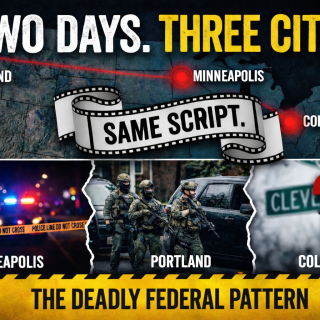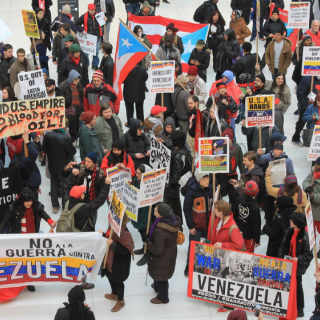Advertisement
Suggestion to Ohio State University:
To pay for owing the former basketball coach $13 million for firing him with years remaining on his contract (and not waiting a few weeks until the season ends), sell the president’s house in Bexley. This is the most distant from campus presidential residence in the United States. Top Gun Carter can move into University Square South, near his office, across the street from the campus itself.
In so doing, OSU would follow the lead of the New School for Social Research in New York City, multiple campuses of the City University of New York, and others: all to meet university debt.
Follow the lead, Bucks.
Fourteenth largest city in the US, endlessly touted from New Albany—from which Columbus is actually governed--through Bexley to Westerville, Worthington, and Dublin, Ohio, all outside the city’s borders—to City Council, the “mayor’s” office, and the so-called media from the non-news, non-daily USA Today/Gannett outlet to NPR’s WO-SU, Fox, and Sinclair Broadcasting: Columbus, Ohio, is now a big city.
No one can find it.
Without the identifying Columbus, OHIO, no one knows which of the many Columbuses across the US and the world. Similarly with The OSU.
Andy Ginther mumbles, “the sun is always rising on Columbus,” but it never reaches its apogee or shines a light or lights. As I demonstrate over and over, when the surface of rhetoric is scratched, the thin veneer bent, the city has no identity and no documented, professional history, no institutions devoted to its study, understanding, and re/development.
The Ohio State University, situated on stolen Indigenous Peoples’ lands which it has never recognized institutionally or apologized unlike most of its peers, has shown little interest in Columbus over its 150 years, even as the city grew to surround it completely. This stands out among both Columbus’ and OSU’s exceptionality or uniqueness among US and world cities and universities. OSU has stopped the city from developing professional football, basketball, and baseball teams—unlike Cleveland and Cincinnati.
But OSU is first in line for tax abatements and income tax rebates which its senior managers admit off the record that it doesn’t need. OSU joins the city in destroying historic neighborhoods, reducing safety, and promoting debilitating traffic problems. Having few robber-barons over the centuries, Columbus lacks the cultural and other distinctive and nationally or internationally known institutions of other Ohio cities including Dayton and Toledo as well as Cleveland and Cincinnati.
Doubts ripple through the same chambers and broken, trash-strewn roadways. There are signs of a bare glimmer of awareness—barely. Why else does City Council with the prompting of former Mayor Coleman’s Downtown Development Corporation, aka Colemanville, the Columbus Partnership based in New Albany, and the Columbus Metropolitan Club militantly opposed to relevance and expertise endlessly commission recommendations from unqualified outside consultants and ad agencies.
With no leadership and no urban expertise, Columbus actually pays unqualified out-of-town agents handsomely to recommend other potentially qualified consultants to pay even more to recommend strategies to buy and locate “public art” and tell the City what to do with its two statues of namesake Christopher Columbus. For years, they sit in large boxes. Given that no one in City employment knows anything about any other city, they can’t even imagine putting them in a museum or even inside City Hall with historical interpretation. Or, perhaps in Ohio Stadium. Oh, historical/interpretation, whatever might that be?
For any reader who thinks that I exaggerate, consider the results of a recent Columbus Dispatch “survey.” For anyone who thinks that I am making this up, see “Editorial: What do you want this city to be?” published on Jan. 21, 2024, and signed by “Opinion and Engagement Editor” Amelia Robinson for the Editorial Board.
The piece actually begins, “Hypothetically speaking, how would describe your friend Columbus to a potential blind date?” “Your friend”? Without explaining why in 2024, a large city is gender-typed, it continues, “Would you say she was friendly and personable? Would you mention how entertaining she is, or call her ‘fine’ and talk about her natural and man-made beauty? Would Ohio State football or state government even come up? Or would you simply recall her formative years, and describe her as former Cowtown that grown into much more?”
I struggle to repeat this profoundly sexist, anti-historical, and anti-intellectual bullshit, to employ a technical term. A “man-made” she? “Formative years”? And of course, almost everyone knows, Columbus was never a “Cowtown” or known as such. That was a sarcastic off-hand quip by one mayor. Of course, none of that matters to the Columbus Dispatch.
Without explaining survey methods or numbers polled, the Dispatch recklessly confuses “what ‘we’ were, are, and/or want to be.” Of course, “Dispatch readers and community leaders”—synonymous?—had a lot of ideas….”
“When the Dispatch asked readers for their ideas about Columbus’ identity, the idea that Columbus should be a welcoming place came up time after time. ‘Welcoming, accepting, enthusiastic, cooperative and kind,” Sandy Woyach of the Northwest Side wrote in an email.” Should be—not is or was? Of course, that does not constitute an identity for a city of almost one million people. But neither Dispatch, Columbus Metropolitan Club, nor Mid-Ohio Regional Planning Commission care about that.
Slightly more to the subject, readers were asked “What do you think of when you think of Columbus? More than 300” of more than 900,000 populations—but perhaps most daily readers?--responded. That is neither statistically significant nor logically reliable.
“The results were not all that surprising:
36 percent--Ohio State athletics/academics
28 percent--A welcoming Midwest city
24 percent--Something else (not listed)
7 percent--Ohio capital/Statehouse
2 percent--Banking/insurance hub
1 percent--Pro sports—Blue Jackets, Crew, Clippers
1 percent--Columbus Zoo”
In other words, the fourteenth largest city in the US, capital of the state of Ohio, and self-proclaimed center of “Silicon Valley heartland,” purchased by Mike DeWine’s 2022 re-election campaign, has no identity and no sense of past, present, or future.
OSU Buckeyes’ football led by cartoon character Brutus cannot be the identity for a city approaching one million population. College football may be an identity for Tuscaloosa, Alabama (U of A) or Athens, Georgia (U of G). It is not the identity of Ann Arbor, Michigan; Syracuse, New York; or even State College, Pennsylvania. It is certainly not the identity of Los Angeles (UCLA, USC) or Miami, Florida (University of Miami).
“Something else (not listed)” comes much closer even for Columbus.
Robinson descends into self-contradictory, illogical gibberish. Knowing nothing about history or cities and little about Columbus itself: “It is clear that the city cannot rest [?] its future on its past, what it is known for, or the attributes a friend would use to describe it to a potential date.” After doing her best to demonstrate that Columbus has no recognized “past to cling to,” she whines “‘Clinging to the past[‘] is not how you become a ‘welcoming[,] accepting, enthusiastic, cooperative and kind’ community that ‘inspires people to want to come here.” Huh? Come again.
She then falls into disconnected random notes of present-day problems. If I read her accurately—and I am far from certain of that—Opinionist Robinson outlines a negative, off-putting identity of infant mortality, unaffordable housing, homelessness, and violence for Columbus, that would scare all comers away. Has this “journalist’ never taken first-year writing or logic?
Robinson’s Opinion Page printed only two letters to the editor promptly (Jan. 25, 2024). Revealing, both writers actually confess to offering slogans—their own word—rather than terms of identity. As the headline above them puts it, “Is Columbus ‘The heart of Ohio, the heart of the Midwest’ or ‘High Tech Heartland[’]?” The second writer comments, “I think the city should capitalize on our future and brand itself around that image. A moniker ….” On Feb. 2, three more letters appeared. None addressed identity in any recognizable way.
Need I say more?
I end with the Columbus Metropolitan Club. At its weekly panel on Jan. 31, it dared to ask—apparently with a straight face—“Is public art a public good?” The announcement made no attempt, critically, to define either “public art” or “public good.” The discussion was led by “art leaders”—whatever is that?--not urbanists, historians, planners, or taxpayers.
Need I say more?
References by Harvey J. Graff
“Columbus’ identity crisis and its media,” Columbus Underground, July 23, 2021
“For Ohio State, bigger is not better,” Columbus Free Press, Sept. 16, 2021
“Columbus’ University District: Students and the institutions that fail them,” Columbus Free Pres, Oct. 8, 2021
“Response to Columbus Alive, ‘The list: Reasons that Columbus Underground opinion piece is trash,’ by Andy Downing and Joel Oliphint, Columbus Alive, July 26: A visit to journalism fantasy land,” Busting Myths, Columbus Free Press, Nov. 7, 2021
“Columbus searches for its Downtown with historical, urbanist, and developers’ blinders,” Busting Myths, Columbus Free Press, Dec. 22, 2021
“Columbus, Ohio, searches to be a city: The myth of the Columbus Way,” Busting Myths, Columbus Free Press, Jan. 9, 2022
“Columbus’ major ‘news media’ against democratic politics and the public,” Busting Myths, Columbus Free Press, Mar. 10, 2022
“Is Columbus really a City?” Busting Myths, Columbus Free Press, Apr. 7, 2022
“Columbus isn’t Cowtown or Silicon Valley Heartland; It’s the lawless wild-wild-Midwest,” Busting Myths, Columbus Free Press, April 20, 2022
“How Columbus, Ohio State University, and major developers destroyed a historic neighborhood,” Busting Myths, Columbus Free Press, Part One, Apr. 26, 2022
“How Columbus, Ohio State University, and major developers destroyed a historic neighborhood,” Busting Myths, Columbus Free Press, Part Two, Apr. 29, 2022
“How Columbus, Ohio State University, and major developers destroyed a historic neighborhood—a continuing saga,” Busting Myths, Columbus Free Press, May 2, 2022
“Universities are not giving students the classes or support they need,” Times Higher Education, May 17, 2022
“Franklinton, 1797-2022 and Columbus’ Contradictions, Part 1,” Columbus Free Press, June 5, 2022
“Franklinton, 1797-2022 and Columbus’ Contradictions, Part 2,” Columbus Free Press, June 9, 2022
“The Columbus Way versus the rights of residents, Part One,” Busting Myths, Columbus Free Press, June 21, 2022
“The Columbus Way versus the rights of residents, Part Two, Busting Myths, Columbus Free Press, June 24, 2022
“The Columbus Way versus the rights of residents, Part Three,” Busting Myths, Columbus Free Press, June 27, 2022
“The Columbus Way versus the rights of residents, Part Four,” Busting Myths, Columbus Free Press, June 30, 2022
“Remaking the City of Columbus for the 21st or is it the 20th century?” Busting Myths, Columbus Free Press, July 5, 2022
“Mr. Mayor and City Council: May I introduce you to the city of Columbus? Beyond the Short North and the Scioto River Bank, there is a diverse complicated city,” Busting Myths, Columbus Free Press, July 31, 2022
“Still searching for Downtown: ‘Ideas considered for Downtown plan,’” Busting Myths, Columbus Free Press, Aug. 14, 2022
“Columbus continues as franchise and fast-food chain leader: Columbus Classical Academies,” Busting Myths, Columbus Free Press, Aug. 24, 2022
“The United States’ most disorganized university? Ohio State’s ‘5½ D’s’: Disorganization, dysfunction, disengagement, depression, dishonest, and undisciplined, Part One,” Busting Myths, Columbus Free Press, Aug. 28, 2022
“The United States’ most disorganized university? Ohio State’s ‘5½ D’s’: Disorganization, dysfunction, disengagement, depression, dishonest, and undisciplined, Part Two,” Busting Myths, Columbus Free Press, Aug. 31, 2022
“Columbus, meet a ‘real’ city: Toronto,” Busting Myths, Columbus Free Press, Oct. 1, 2022
“City of Columbus and The Ohio State University: Two peas in a pod, one bigger than the other, relatively speaking, but so much the same. Part One,” Busting Myths, Columbus Free Press, Oct. 8, 2022
“The City of Columbus and The Ohio State University: Two peas in a pod, one bigger than the other, relatively speaking, but so much the same. Part Two,” Busting Myths, Columbus Free Press, Oct. 14, 2022
“Why won’t Columbus, Ohio, grow up?” Busting Myths, Columbus Free Press, Oct. 22, 2022
“Andy Ginther as Columbus, Ohio’s very own shabby 21st century limitation of New York City’s 1860-1870s Boss Tweed,” Busting Myths, Columbus Free Press, Nov. 19, 2022
“University bragging rights: OSU whimpers but doesn’t bite or swallow,” Busting Myths, Columbus Free Press, Nov. 27, 2022
“Columbus meet another ‘real’ city, nearby, smaller, but….Pittsburgh,” Busting Myths, Columbus Free Press, Nov. 30, 2022
“Columbus City Council muddies, no--defaces art in public: $250,000 in uninformed boosterism for the ‘little city that can’t,’” Busting Myths, Columbus Free Press, Dec. 8, 2022
“The Ohio State University: Not ‘a failed presidency,’ by itself, but a failing university, Part
One,” Busting Myths, Columbus Free Press, Jan. 7, 2023
“The Ohio State University: Not ‘a failed presidency,’ by itself, but a failing university, Part Two,” Busting Myths, Columbus Free Press, Jan. 11, 2023
“A city versus its neighborhoods: Columbus, Ohio,” Busting Myths, Columbus Free Press, Jan.
25, 2023
“Appreciating—so to speak--Columbus and Ohio humor, such as they are…,” Busting
Myths, Columbus Free Press, 1, 2023
“How can a city with no history destroy its history? The Columbus Way,” Busting Myths,
Columbus Free Press, Mar. 18, 2023
“Why does Columbs have no legitimate media” Busting Myths, Columbus Free Press, Apr.
2023
“Lawless, Unsafe, and Dirty: The Dying University District.” Busting Myths, Columbus
Free Press, May 2, 2023
“Ohio State University and its Dying University District: The Oval and the Campus
Beyond,” Busting Myths, Columbus Free Press, May 5, 2023
“Columbus’ identity failure: The mad scramble to fabricate a ‘brand’ for the biggest little
city in the US,” Busting Myths, Columbus Free Press, May 11, 2023
“The private city and the secret city: Columbus is dying and no one in Colemanville knows
or cares. Part One,” Busting Myths, Columbus Free Press, May 20, 2023
“The private city and the secret city: Columbus is dying and no one in Colemanville knows
or cares. Part Two,” Busting Myths, Columbus Free Press, May 25, 2023
“The private city and the secret city: Columbus is dying and no one in Colemanville knows
or cares. Part Three,” Busting Myths, Columbus Free Press, June 2, 2023
“After more than 150 years, The Ohio State University administration abandons campus
and the landmark Oval, and secretly goes into hiding off-campus,” Busting Myths, Columbus Free Press, June 21, 2023
“The 150-year-old, 90,000 student-staff-and faculty university that won’t grow up: The
Ohio State University Buckeyes led by Brutus Buckeye, Part One,” Busting Myths, Columbus Free Press, Aug. 23, 2023
“The 150-year-old, 90,000 student-staff-and faculty university that won’t grow up: The
Ohio State University Buckeyes led by Brutus Buckeye, Part Two,” Busting Myths, Columbus Free Press, Aug. 30, 2023
“Columbus is lost among midwestern metropolises. Can it learn from others and finally
begin to find itself? Or is it too late?” Busting Myths, Columbus Free Press, Oct. 4, 2023
“A major huge university versus its students, neighbors, and their city: The Ohio State
University,” Busting Myths, Columbus Free Press, Nov. 2, 2023
“Slogan University Revisited. When did Offices of Compliance and Integrity [sic]. Student
Life, Student Conduct, Campus Safety become just the opposite? The example of one of the largest U.S. universities, Part One,” Columbus Free Press, Nov. 14, 2023
“Slogan University Revisited. When did Offices of Compliance and Integrity [sic]. Student
Life, Student Conduct, Campus Safety become just the opposite? The example of one of the largest U.S. universities,” Part Two, Busting Myths, Columbus Free Press, Nov. 19, 2023
“The City of Columbus continues to prove itself incapable of learning: The contradiction
and corruption of ever-expanding public subsidies for private development ‘tax
abatements,’” Busting Myths, Columbus Free Press, Nov. 26, 2023
“Exposing the Obvious: Columbus City Council Commits Fraud with its Fake District
Representative Deceptive Marketing Scheme,” Busting Myths, Columbus Free
Press, Dec. 17, 2023
“There is no Columbus Dispatch; Columbus does not have a daily news-paper: Yet they
continue to demand advance payment and bill regularly, Busting Myths, Columbus
Free Press, Dec. 28, 2023
-------------------------------------------------------
Harvey J. Graff is Professor Emeritus of English and History, inaugural Ohio Eminent Scholar in Literacy Studies, and Academy Professor, Ohio State University. Author of many books on literacy, children and youth, cities, and interdisciplinarity, most recently he published Searching for Literacy: The Social and Intellectual Origins of Literacy Studies (2022). My Life with Literacy: The Continuing Education of a Historian. The Intersections of the Personal, the Political, the Academic, and Place is forthcoming. “Reconstructing the new ‘uni-versity’ from the ashes of the ‘multi- and mega-versity’” is in progress. He is also editing Changing Paths of Academic Lives: Revising How We Understand Higher Education/Universities, 1960s to 2020s and Beyond, a collection of original first-person essays.



